What to bring on a Global Village trip
This generic list is based on our past experience. It will be augmented for each individual journey with any additional specific requirements that we discover during our research and preparation.
A Road Less Traveled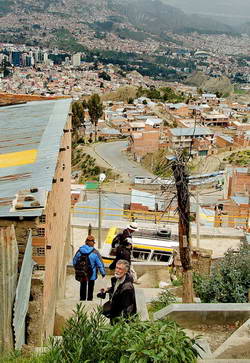
La Paz, Bolivia
Photo by Dave Bezaire
Safe Traveling
A few simple precautions will help keep you and your possessions secure while traveling.
- Keep a hand on your backpack with all of your things zipped inside.
- Before entering the security checkpoint, put everything from your pockets into your backpack, and keep your passport and airline ticket in your hand. Don't let your things enter the machine until you can walk directly through the scanner to receive them as they emerge.
- Keep the receipts for your checked luggage! They will be needed if anything is delayed or lost. Usually they are pasted on the airline ticket jacket.
- Keep your passport, extra cash, and credit card(s) in a money belt or neck pouch worn under your clothing. (We know, ladies think this makes them look fat. But, it's still a very wise precaution!)
- Whenever possible, stick with a group as you move about.
- Wear your Habitat for Humanity Global Village T-shirt for the flight into the country to help us find each other and so that our hosts can identify us upon arrival.
By the way, if you have not already done so, we encourage you to please review our What To Expect page for a more complete picture of the entire experience.
Luggage
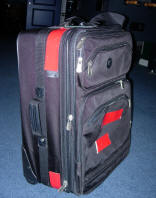
Photo by Dave Bezaire
Keep your luggage as light and compact as possible - you will be responsible for carrying it!
You should bring:
- One sturdy suitcase, typically with wheels to make it easy in the airports. You will want it to be large enough to have some empty space at the beginning, because you will likely want to bring back some souvenirs. For convenience, we always mark our suitcases to make them easy to identify in the sea of similar luggage at the airport. A couple pieces of colorful duct tape work very well! Normal airline regulations apply, typically limiting your suitcase to 50 pounds.
- One sturdy backpack that you can carry-on the flight and use as a daypack to go to the work site or on excursions. It is very important that the backpack is large enough to contain your camera, sunscreen, medicines and everything else that you will want to carry on a daily basis, and that it can be zipped closed so that nothing gets lost.
Every piece of luggage should have two identification tags -- one secured to the outside, and another someplace on the inside. Below is a sample of the suggested tag format. Check back just before departure for a complete version with all address information and phone numbers included.
If found, please contact: your name
From start date through end date:
Habitat para la Humanidad - Nicaragua, GV Team your GV Team #
HFH street address
HFH city, state, country
Telephone: HFH telephone Cell: HFH cell phone
Contact: HFH contact name(s)
At all other times:
your city, your state, your country
Telephone: your phone or alternate phone
Smiling Dominican child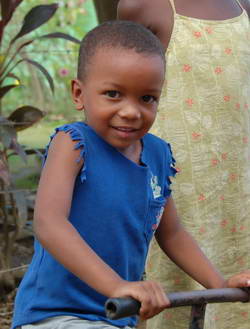
Outside Punta Cana, Dominican Republic
Photo by Dave Bezaire
Cement is messy!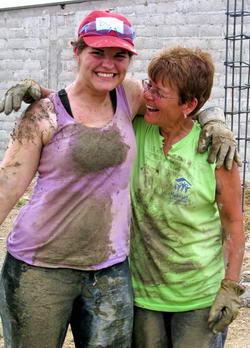
Guayaquil, Ecuador
Photo by Susi Havens-Bezaire
A YMCA break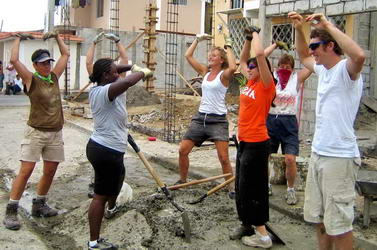
Guayaquil, Ecuador
Photo by Sarah Boone
Bucket brigade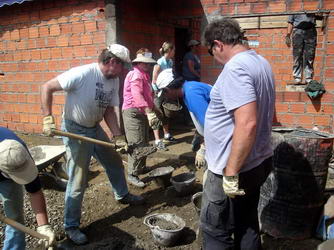
Tarija, Boliva
Photo courtesy of Escarlem Rodriguez
A Road Less Traveled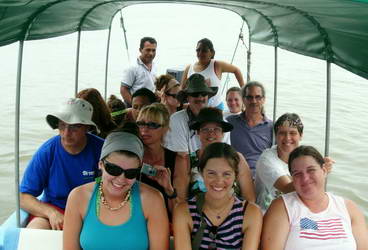
Rio Dulce, Guatemala
Photo courtesy of Shannon Baines
Tying rebar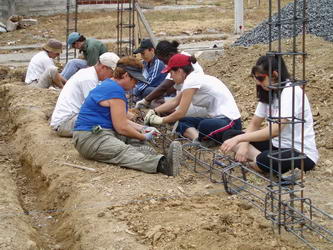
Guayaquil, Ecuador
Photo courtesy of Caren Truske
Special Note for Women
The dress standards in many developing countries, especially outside of larger cities, tend to be rather conservative. To feel most comfortable and avoid attracting unwanted attention, it is prudent to choose knee-length or longer skirts, and either pants or capris rather than shorts. Remember that on a construction site you will be bending, lifting, reaching and twisting, so please choose clothing that keeps you covered while doing such gymnastics. Also note that loose fitting clothes will be more comfortable in a warm climate.
Packing List
Credentials and Cash
- Passport, drivers license, and health insurance card
- One extra copy of your passport, identification, and emergency contact information
- Neck or stomach pouch to carry credentials, cash, credit cards, etc.
- Cash. Travelers checks can be used, but the easiest way to obtain cash is via an ATM.
- A small, sealable bag clearly marked with your name in which to store your credentials and cash for safekeeping. Often we all place such items in a common safety deposit box, so a gallon-size zip lock bag is useful to keep your things together.
Tools
- Leather or rubber-palm work gloves
- Back support for lifting
- Water bottle marked with your name
- Safety glasses
- Ear protection (might be used at night as well if hotel is noisy!)
Clothing
We generally expect to wash clothing every few days, usually at a nearby laundry service or sometimes at the place we are staying. Although they sometimes offer same-day service, we plan for a two-day turnaround because they often lack adequate dryers.
Make sure your clothing and underwear is made of natural fibers. Lightweight cotton is best in the heat of the day. At higher elevations, the temperature may be cool in the mornings and evenings. During the day it will be very hot and likely quite humid. Long sleeve shirts and long pants will likely be recommended in mornings and evenings to protect from mosquitoes. (You can always cut them off.)
- 3 sets of daily work clothes. Loose fitting cotton clothing that can be considered "disposable" at the end of the trip is advised. Many people pick up used clothes, medical scrubs, etc. at a Goodwill or similar store. Each set should include:
- Long pant or capris
- T-shirt
- Socks
- work shoes (light weight leather or heavy tennis shoes; some people prefer to bring two pairs in case the work site is wet and muddy)
- Sweat bands (elastic, cotton scarves or handkerchiefs, etc.)
- 3 days of travel/r&r clothes, one set of which should be appropriate for church service. Include things such as:
- Lightweight pants, capris, or knee length shorts or skirts
- Sport shirts, casual tops, tee-shirts
- Sandals and/or tennis shoes
- 5 sets of underwear
- 1 set of long underwear for cold nights in unheated hotel rooms
- 1 light winter coat for La Paz, with hat and mittens
- 1 sweater or light jacket for cool construction mornings
- 1 light weight long sleeve shirt for cool mornings and “buggy” evenings
- 1 light weight rain jacket or poncho
- Flip-flops for showers
- Hat, preferably one that covers your neck and ears
- If you burn easily, bring 2 extra long sleeve shirts for UV protection
- Swimsuit
Toiletries
- Travel size baby wipes or hand wipes or hand sanitizer
- Individual size Kleenex or tissue package(s)
- Prescription medications
- Imodium-AD and CIPRO
- First aid supplies as desired to complement the team first aid kit
- Bengay or similar for sore muscles
- Insect repellent with approximately 20% to 25% Deet
- Sunscreen
- Bath soap and shampoo in travel shower bag
- Nail clippers (In checked luggage, not carry-on)
- Dental floss, tooth brush and tooth paste
- Personal cosmetics & toiletries
- Face cloth and bath/swim towel (not a big beach towel)
- Soap if planning to wash delicates in room
- Items for contact lenses
- Travel alarm clock
Miscellaneous
- Personal snacks – in zip lock bags
- Sunglasses
- Camera, batteries & charger
- Journal, pens and pencils
- Books
- Small flashlight and batteries
- Family photos to show new friends
- Extra Ziplock bags - keeps things organized and keeps things from getting dusty
- A Ziplock-XL bag is great for taking dirty clothes to the laundry
- Electric adapter / converter
- Morning devotion resources
- Local language dictionary or phrase book

 Who
Who